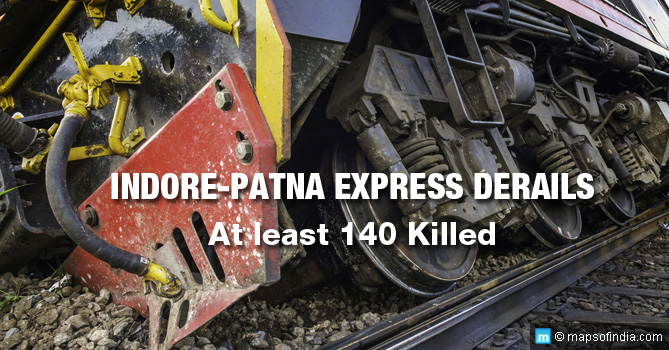The Patna-Indore Express derailment brings in a reality check for the safety status of Indian Railways.
Fourteen carriages of the Indore-Patna Express, travelling with more than 500 passengers, derailed just after 03:00 am local time on Sunday, 60 km from Kanpur, causing the death of 133 passengers. Being the early morning hours, most of the passengers were sleeping and were caught unawares. Witnesses say that they were woken up with a jolt as they heard a loud bang, and then there was death and destruction everywhere. TV visuals showed the coaches smashed up against each other and rescue workers trying to cut through crumpled metal to pull out trapped passengers.
The worst hit coaches were S2 and S3 with the maximum number of deaths reported from these coaches. Rescuers worked until late morning of November 21, 2016, trying to reach the injured and recover the dead from the twisted carriages. Apart from the police and the local villagers, the army as well as the NDRF were also called in for the rescue operations.
Prime Minister Modi has said that he was “anguished beyond words” and has asked the Railway Minister Suresh Prabhu to look into the matter and take serious action if required. An ex-gratia for the kin of the dead as well as the injured has been announced.
The cause of the crash near the village of Pukhrayan has not yet been ascertained but following are some of the reasons which may have led to the derailment:
- The primary reason seems to be “rail fracture” caused due to expansion of tracks in summer and contraction during winter.
- The train was speeding at 100 kmph when it flew off the tracks causing derailment of 14 coaches and more destruction.
- The death toll due to the derailment was more because the coaches were old and not the newly introduced Linke Holfmann Bush (LHB) coaches, which are made of stainless steel and have built-in safety features which can absorb the shock and impact of derailment and thus do not topple over.
Some Bad News From the Past
India has seen some of the worst train accidents in the past.
- The worst rail disaster occurred on June 6, 1981, in Bihar when a train derailed and plunged into the Bagmati River — killing 600 of the 1000 passengers.
- On August 20, 1995, 400 people were killed when Puroshottam Express rammed into the Kalindi Express in Uttar Pradesh.
- On November 26, 1998, Jammu Tawi-Sealdah Express collided with the derailed coaches of the Frontier Mail in Punjab, killing 212 people.
- 299 people were killed in a collision between two trains at Gaisal in Assam on August 2, 1999.
- 100 people died when a bogie of the Howrah-Delhi Rajdhani Express fell into a river in Bihar on September 9, 2002.
- The Gyaneshwari Express derailed in Bengal following sabotage of the tracks by Naxals resulting in the death of 148 passengers.
India’s Railway Network
India has the third longest railway network with 115,000 km of track and 7112 stations. 22 million passengers travel by train every day. Having said that, the condition of the tracks as well as the trains, and the management of the rail network in India have a tremendous scope for improvement. In 2014 alone, railway related deaths amounted to 27,581.
Not in the news fortunately because of no casualties, there have been 3 other derailments in 2016 alone.
- The Jammutavi-Pune Jhelum Express derailed with 165 Pune-bound passengers on October 5, 2016. Nine coaches of the train derailed but thankfully, no one was injured.
- A goods train derailed at Karunagappalli Station near Kollam on September 20, 2016. No one was injured.
- On August 28, 2016, 12 coaches of Thiruvananthapuram-Mangalore Express derailed near the Karukutty station. However, no casualties were reported in this incident.
Maintenance
Due to lack of adequate funding, maintenance of the railway network in India is far from satisfactory.
- The frequent derailments are due to deficiencies in track management.
- There is a lack of proper security measures like an automatic fire alarm system, which could save lives in case of emergencies like fire. In 2013, there was a fire in 2 AC coaches of an express train plying between Bangalore and Nanded that killed 26 people.
- In spite of the Linke Holfmann Bush (LHB) coaches having been introduced, most of the trains still have the old coaches which are devoid of the in-built safety features that the LHB coach provides.
Precautions to be Taken
The Indian Railways has to step up efforts immediately and take the following actions for the safety of its passengers:
- Every old coach has to be replaced by the newer, more secure ones at the earliest.
- The signalling system needs to be improved.
- The innovative technology called the Anti-Collision Device (ACD), developed by Konkan Railway, needs to be deployed at the earliest which will help in reducing accidents due to collision between trains.
- The distressed bridges have to pinpointed and repaired, and new ones built.
- The old and dilapidated tracks need to be replaced by new ones, and the existing ones need to be maintained regularly so that there no derailments.
Conclusion
The decision of the Modi Government to do away with a separate Railway Budget and combine it with the Union Budget from the fiscal year 2017, will save the Railways 10,000 crore. At present, Indian Railways pays about Rs 10,000 crore as dividend a year after getting about Rs 40,000 crore. The cash-strapped Railways can now use this additional fund towards the improvement of the railway network in India. Apart from this, new policies can be initiated and implemented at a faster pace and this will include the change of coaches as well as track management and introduction of better technology for the safety of the passengers.
Read More…..
How is India Planning to Stop Train Accidents?
Indian Railways “Experiments” with Surge Pricing in Premier Trains
Free Wi-Fi Services in Indian Railway Stations
Indian Railways: Looking Back Into the Past
Indian Railways: Sweeping Changes in Booking of Tatkal Tickets
Cleanest and Dirtiest Railway Stations in India
Railway Budget 2016: An Analysis
India’s First Railway University
Railway Budget 2016 Highlights
List of Major Rail Accidents in India
Google to Provide Wi-Fi Hotspots at 500 Railway Stations






